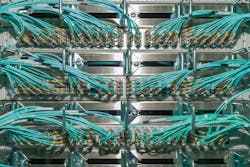Bend-insensitive multimode fiber (BIMMF) was introduced more than 15 years ago as a solution to the challenge of attenuation caused by tight bends in fiber-optic cabling systems. A multimode optical fiber will suffer signal loss, or attenuation, when the fiber is curved or bent more tightly than a defined radius. A multimode link that includes BIMMF is more forgiving in that regard, allowing cabling installers and technicians more leeway with how they physically route cables in tight workspaces.
Bend-insensitive multimode fiber caused quite a stir when it was introduced, challenging industry norms about the design, installation, and testing of multimode fiber-optic cabling systems. Here are 5 things you should know about BIMMF, including some historical context and practical notes for its use today.
1) BIMMF was introduced in 2009 and was a “revolution” in the evolution of multimode fiber.
Over the approximate decade preceding BIMMF’s introduction, multimode fiber evolved technologically to support higher data-transmission speeds, particularly including Gigabit Ethernet then 10-Gigabit Ethernet. With the introduction of GbE, 62.5-micron multimode fell out of favor and 50-micron multimode grew in popularity because of its ability to support GbE for longer distances than 62.5. MMF further advanced with the development of laser-optimized 50-micron, which—as its name indicates—is constructed specifically for the purpose of carrying signals generated by laser (VCSEL) sources. Eventually, through standardization and characterized by their modal bandwidth performance, 62.5-micron fiber became known as OM1, non-laser-optimized 50-micron became known as OM2, and laser-optimized 50-micron became known as OM3. OM4 fiber has an even higher modal bandwidth than OM3. Each successive grade of MMF improved on its predecessor thanks to the relationship between the fiber’s core and its cladding. The higher the grade of fiber, the fewer higher-order modes of light it allows to escape from the core and enter the cladding. Stressing the optical fiber by bending it increases the loss of these higher-order modes from the core into the cladding. Prior to the introduction of BIMMF, industry best practices called for a minimum bend radius of approximately 30 mm for multimode fiber-optic cable. In a bend-insensitive multimode fiber, the cladding is significantly altered or enhanced to prevent the escape of higher-order modes from the core. Providers of BIMMF said the medium could withstand a bend radius of 7.5 mm and still perform to expectations.
2) BIMMF shook up the fiber-manufacturing process and prompted critical evaluation.
Optical-fiber manufacturer Corning developed its version of BIMMF essentially in stealth mode, announcing to the industry in January 2009 it had created the fiber type and pronouncing its performance capabilities under tight bends. Corning also declared BIMMF could be integrated essentially seamlessly with existing 50-micron fiber. Not everybody agreed. In the early-2010s, we at Cabling Installation & Maintenance published numerous articles and positioning statements in which technical arguments played out. Some described the physical characteristics of a BIMMF and why those physical characteristics created incompatibility with existing 50-micron MMF. Others maintained that some BIMMFs would experience such compatibility problems while others would not. The persuasive arguments, each reinforced by in-depth technical research, were watched closely by many users who were considering whether or not to specify BIMMF in their networks.
3) Test procedures and tools had to evolve.
Years before the introduction of BIMMF, technicians who tested installed multimode fiber-optic links got familiar with using a mandrel as part of the testing process. Because fiber testers used LED (not laser) sources, they produced what is called an overfilled launch condition, which is more or less what it sounds like—the source within the tester overfills the reference cord, which results in inconsistent readings. With the emergence of laser-based Gigabit and 10-Gigabit Ethernet, the LED-based overfilled launch condition did not mirror the real-world transmission conditions under which the installed link would operate. To improve testers’ accuracy, the use of a mandrel was added to the process. A test technician wraps the reference cord around a mandrel between 17 and 25 mm in diameter, depending on the fiber and cable type under test. Wrapping the cord around the mandrel multiple times strips out higher-order modes and produces a more-consistent, more-accurate test reference.
Enter BIMMF. With its much-better loss performance, to achieve consistent and accurate test results, BIMMF required the use of a smaller mandrel—approximately 4 mm in diameter and for more turns than are required around a larger mandrel for non-BIMMF. But that only solved part of the problem; while the more-wraps-around-a-smaller-mandrel technique worked in the 850-nm operating window, it was not sufficient for the 1300-nm window. That is why the term “encircled flux” (EF) entered the ICT industry vocabulary. Described by Fluke Networks as “a metric for defining launch conditions on multimode optical fiber that reduces measurement uncertainty in link loss measurements,” EF was introduced in the form of adapters for fiber-test equipment. It was identified in the TIA-526-14-B standard Optical Power Loss Measurements of Installed Multimode Fiber Cable Plant. Today the encircled flux launch condition is built into many fiber testers.
4) BIMMF is recognized, and recommended, in standards.
In 2015 the IEC 60793-2-10 standard identified bend-insensitive multimode fiber. At that time, optical-fiber manufacturer OFS explained, “Led by OFS, industry standards organizations worked to ensure that BIMMF was interoperable with existing OM4 and OM3 50-micron multimode fibers, to help provide the low loss and highly reliable bandwidth required by today’s demanding networks … Significant changes were made to testing procedures for NA [numerical aperture] and core diameter to ensure that backward compatibility with non-bend-insensitive fibers was maintained.”
The ANSI/TIA-568.3-E standard, published in 2022, recommends the use of BIMMF in high-density environments, and where space constraints make it impractical for installers and technicians to accommodate a larger bend radius.
5) You might be using BIMMF today without even realizing it.
With its established history, demonstrated backward-compatibility with other multimode fiber types, and availability from the world’s largest suppliers of multimode optical fiber, you may have installed BIMMF without even knowing it. In fact, Corning began using BIMMF as its standard 50-micron multimode fiber offering in 2010—in the midst of the technical debate ongoing at the time.
From its disruptive arrival more than 15 years ago to its widespread use today, bend-insensitive multimode fiber has left an indelible mark on the technological landscape of local area network planning, installation, and administration.
About the Author
Patrick McLaughlin
Chief Editor
Patrick McLaughlin, chief editor of Cabling Installation & Maintenance, has covered the cabling industry for more than 20 years. He has authored hundreds of articles on technical and business topics related to the specification, design, installation, and management of information communications technology systems. McLaughlin has presented at live in-person and online events, and he has spearheaded cablinginstall.com's webcast seminar programs for 15 years.

